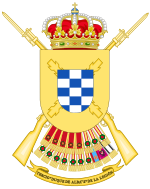
The Tercio "Duque de Alba" No. 2 of the Legion" is an infantry regiment of the Spanish Legion. It is based in Ceuta and commands the 4th (Protected Infantry Bandera "Cristo de Lepanto" IV/2). [1]

The Tercio "Duque de Alba" No. 2 of the Legion" is an infantry regiment of the Spanish Legion. It is based in Ceuta and commands the 4th (Protected Infantry Bandera "Cristo de Lepanto" IV/2). [1]